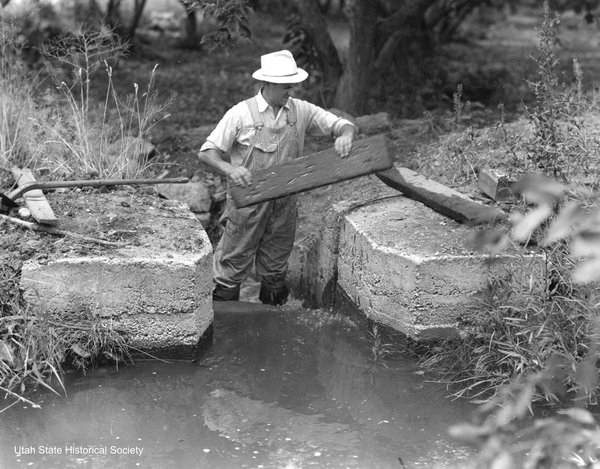Dublin Core
Title
Description
Utah’s irrigation system of canals, ditches, dams, and reservoirs are essential to the state’s agricultural economy, but the system has long relied on humans to actually regulate the water. Each county assigned a watermaster to allocate and monitor individual water use to ensure fair access to the state’s limited water supply. The watermaster’s job was challenging, and often made more difficult by the personalities of local farmers and their demands for increased water.
The watermaster position began shortly after Mormon settlement in 1847. Communities initially looked to their church’s leadership to serve in the role, often appointing the local bishop who made decisions based on appraisals of religious worthiness. In 1851, however, the new territorial legislature gave incorporated cities the authority to choose watermasters. The shift to this more democratic arrangement was slow, but by the 1870s, towns were forming irrigation districts and appointing the watermaster at community meetings.
Work for the appointee included traveling between farms and irrigation canals. Each farm had its own headgate and measuring weir, which controlled the flow of water onto the farmer's land. Watermasters carried a large measuring stick – one side marked with the usual twelve inches per foot and the other divided the foot into tenths and hundredths. This stick measured water flow and depth, and was the watermaster’s most important tool because it gauged necessary adjustments or repairs to the water supply. In theory, only the watermaster was authorized to adjust the flow of water through the headgate, but this was on the honor system. Despite clear regulations, many farmers spent hours – and late nights – attempting to get more than their fair share of the water. Opening the headgate a little wider – also known as “midnight irrigating” – was especially problematic during periods of drought.
The position of watermaster was well respected, but their work was often thankless. In many cases the job required reasoning with angry and desperate farmers to keep the peace. A human face was valuable to encourage fair regulation of water in ways that served both the individual and the community. Even today, watermasters guard this shared community resource in irrigation systems all over Utah.
Creator
Source
_______________
See Lavell Johnson, “The Watermaster’s Stick,” Utah Historical Quarterly 42, no. 2 (Spring 1974), pp. 190-196; Glen M. Leonard, A History of Davis County, Salt Lake City, UT: Utah State Historical Society, 1999; Wells A. Hutchins,Water Rights Laws in the Nineteen Western States vol. 3, Natural Resource Economics Division, Economic Research Service, United States Department of Agriculture, 1977; Craig Fuller,Irrigation in Utah, Utah History Encyclopedia.

